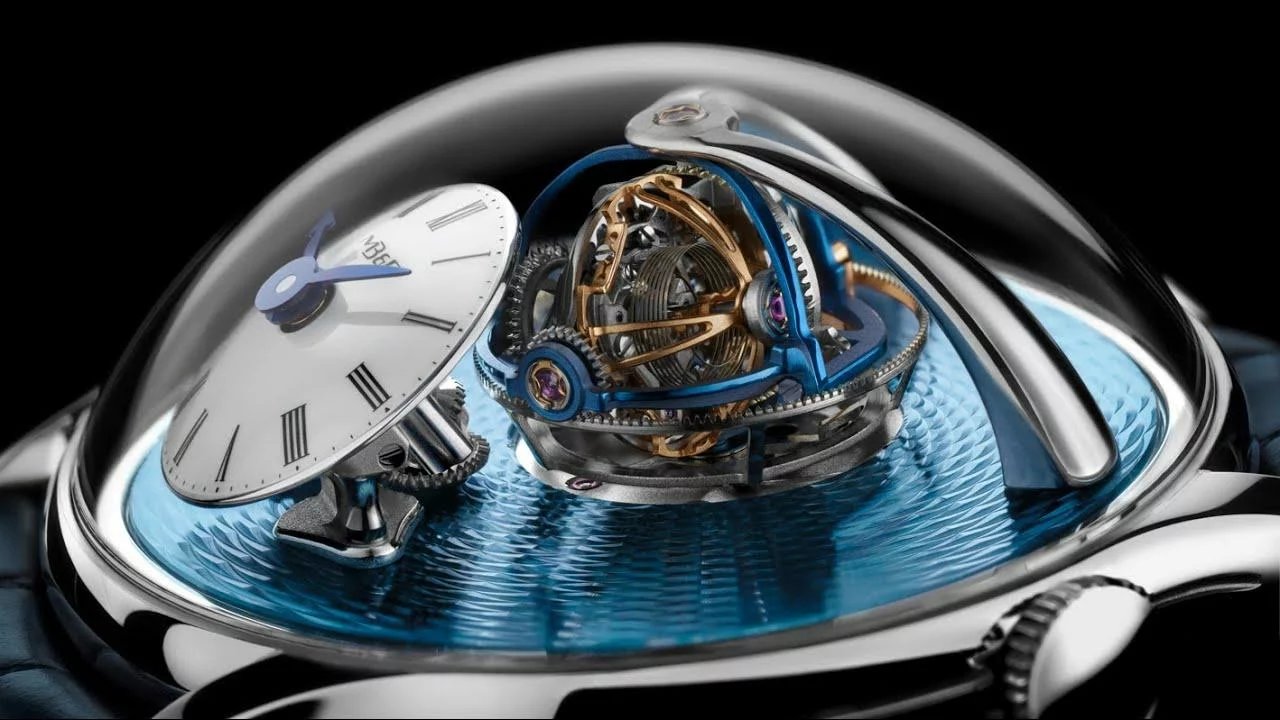Table of Contents
The whirlwind, this miniature theater that never ages
It only takes one look to understand: a rotating cage, a pulsing balance wheel, reflections of mirror-polished steel. This is a complication that hypnotizes from the first blink. The tourbillon belongs to this family of crazy ideas which, in watchmaking, have crossed the fine line between utility and pure culture. Two centuries after its birth, it remains one of the ultimate markers of know-how, the fetish that tells the history, science and style of a house.
An invention against gravity
Patented in 1801 by Abraham-Louis Breguet, the tourbillon was born from a very concrete problem: gravity disrupts the regulating organ of pocket watches, often worn vertically. By rotating the sprung balance and the escapement in a cage (most often in one minute), Breguet hopes to average out errors and improve regularity. At the time, the observatory was a court and precision was a competitive sport. The complication stands out as a chronometry tool as much as an engineering signature.
From laboratory to legend
The 20th century shook things up: the watch was worn on the wrist, constantly changing positions and, paradoxically, made less use of the tourbillon for strictly chronometric reasons. But the idea doesn’t go away. In 1920, in Glashütte, Alfred Helwig imagined the “flying” tourbillon, stripped of its upper bridge, as if suspended in a void — a gesture of architecture as well as watchmaking. Then, in 1986, Audemars Piguet initiated the first mass production of an ultra-thin wristwatch tourbillon, marking the modern renaissance of the complication. From then on, history accelerates: Jaeger-LeCoultre will play the balancing act with its multi-axis Gyrotourbillon, Greubel Forsey will reinvent geometry with its inclined tourbillons, and the whole of fine watchmaking will see it as a territory of expression.
- 1801: Breguet patents the tourbillon.
- 1920: Alfred Helwig creates the “flying” tourbillon.
- 1986: return to the wrist, with a mass-produced ultra-thin tourbillon.
- 2000s: creative explosion, multi-axes, inclined cages, modern materials.
Why collectors love it
If the complication still fascinates, it is first and foremost because it lays the mechanics bare. The whirlwind is not hidden; he shows himself at six o’clock, at noon, sometimes right in the center. It is the “ballet” of the watch, the moment where the know-how becomes clear: hand beveling, black polish on the cage arms, curved shapes, blued screws. The straight lines become gouache, the curves seem alive. The object tells a story of hands, of repeated gestures, of patience. And this is where culture takes precedence over pure function: the tourbillon is a stage where the house expresses its aesthetic grammar and its mastery of long-term time.
- Mechanical theater: a visible, narrative, almost cinematographic complication.
- House signature: each cage architecture tells a style.
- High finish: examining the thread count becomes an insider’s ritual.
- Controlled rarity: handmade, time spent, high standards.
Myth versus chronometric reality
The truth of observatory desks is not exactly that of the wrist. In movement, in multiposition and sometimes equipped with modern materials (silicon hairspring, variable inertia balance), a caliber without a tourbillon can compete with — or even surpass — a poorly adjusted tourbillon. But the myth is not just about the second gained: it is about the consistency in certain positions, the difficulty of focusing, the intrinsic beauty of the solution. Modern competitions have shown it: tourbillons designed for performance remain formidable. The rest comes down to the alchemy between watchmaking and emotion.
Variations: when the whirlwind reinvents its dance
The vocabulary has been enriched. Steering wheel, double or triple axes, inclined at 30°, mounted on an equalizer winder, coupled to a chain fusee, miniaturized for extra-flat cases: the complication has explored all avenues. Some prioritize expressiveness (the hypnotic, multi-axis spherical cage), others performance (tilt calculated to optimize the average in positions). Between the lines, the story continues: we feel the workshop spirit, the search for the right compromise between spectacle and substance.
- Architecture of the cage: symmetries, lightness, controlled inertia (titanium, alloys).
- Real finishes: clean beveling, sharp edges, black polish, consistent beading and ribbing.
- Useful features: stop-seconds on the tourbillon, seconds on the cage, readable power reserve.
- Regulation: quality hairspring (overcoil, stable materials), balance with weights.
- Frequency and autonomy: balance between precision and endurance.
- Service and sustainability: in-house know-how, access to parts, clear guarantee.
- Design language: the dial and the cage must dialogue, not ignore each other.
A good tourbillon can be recognized by its coherence: beauty of the gesture, rigor of the construction, accuracy of the narration. He doesn’t need to overdo it; he must do it right, and well.
Some milestones to know
- The historic pocket tourbillon: roots of the complication, aesthetics of the observatory.
- The first mass-produced wristwatch tourbillon of the 1980s: proof that the idea can live on the wrist.
- The “steering wheel”: a suspension which visually lightens the mechanics.
- The multi-axis and the inclined: three-dimensional exploration, between kinetic art and the search for regularity.
- The stop-second tourbillon: precision serving time setting, a sign of contemporary thinking.
Beyond the complication, a culture
In a world saturated with screens, the whirlwind reminds us that beauty can be mechanical, that time has depth. It is not just a complication: it is a living chapter in watchmaking history, a language shared by workshops and collectors, a ritual that is passed down. To see it turn is to accept that the superfluous can reforge the essential: the intimate relationship we have with the object, the hand and time.
And that is perhaps the secret of his fascination. The tourbillon no longer has to prove its usefulness; it proves something else, something rarer: that engineering can be poetry, and that heritage, when carried well, never weighs. He elevates.






